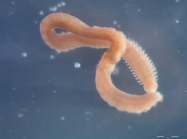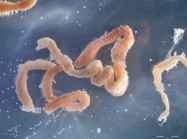
| Introduction | | Search taxa | | Taxon tree | | Taxon match | | Checklist | | Literature | | Stats | | Photogallery | | OBIS Vocab | | Log in |
CaRMS taxon detailsAricidea Webster, 1879
129430 (urn:lsid:marinespecies.org:taxname:129430)
accepted
Genus
marine,
recent only
Webster, Harrison Edwin. (1879). The Annelida Chaetopoda of the Virginian coast. <em>Transactions of the Albany Institute.</em> 9: 202-269, plates I-XI., available online at https://biodiversitylibrary.org/page/43082522
page(s): 255 [details]
description Median antenna present; modified setae either pseudocomposite or recurved with a subterminal arista arising from the...
description Median antenna present; modified setae either pseudocomposite or recurved with a subterminal arista arising from the concave side of the shaft. [details]
Read, G.; Fauchald, K. (Ed.) (2021). World Polychaeta Database. Aricidea Webster, 1879. Accessed through: Nozères, C., Kennedy, M.K. (Eds.) (2021) Canadian Register of Marine Species at: http://www.marinespecies.org/carms/aphia.php?p=taxdetails&id=129430 on 2024-04-23
Nozères, C., Kennedy, M.K. (Eds.) (2024). Canadian Register of Marine Species. Aricidea Webster, 1879. Accessed at: https://marinespecies.org/carms/aphia.php?p=taxdetails&id=129430 on 2024-04-23
Date action by
original description
Webster, Harrison Edwin. (1879). The Annelida Chaetopoda of the Virginian coast. <em>Transactions of the Albany Institute.</em> 9: 202-269, plates I-XI., available online at https://biodiversitylibrary.org/page/43082522
page(s): 255 [details] taxonomy source Erdoğan-Dereli, Deniz; ÇInar, Melih Ertan. (2020). The diversity of the genus Aricidea (Polychaeta: Paraonidae) from the Sea of Marmara, with descriptions of two new species and two new records for the Mediterranean fauna. <em>Zootaxa.</em> 4844(1): 1-73., available online at https://www.biotaxa.org/Zootaxa/article/view/zootaxa.4844.1.1 [details] Available for editors additional source Glasby, Christopher J.; Read, Geoffrey B.; Lee, Kenneth E.; Blakemore, R.J.; Fraser, P.M.; Pinder, A.M.; Erséus, C.; Moser, W.E.; Burreson, E.M.; Govedich, F.R.; Davies, R.W.; Dawson, E.W. (2009). Phylum Annelida: bristleworms, earthworms, leeches. <em>[Book chapter].</em> Chapt 17, pp. 312-358. in: Gordon, D.P. (Ed.) (2009). New Zealand inventory of biodiversity: 1. Kingdom Animalia: Radiata, Lophotrochozoa, Deuterostomia. Canterbury University Press, Christchurch. [details] Available for editors additional source Fauchald, K. (1977). The polychaete worms, definitions and keys to the orders, families and genera. <em>Natural History Museum of Los Angeles County: Los Angeles, CA (USA), Science Series.</em> 28:1-188., available online at http://www.vliz.be/imisdocs/publications/123110.pdf [details] additional source Bellan, G. (2001). Polychaeta, <i>in</i>: Costello, M.J. <i>et al.</i> (Ed.) (2001). European register of marine species: a check-list of the marine species in Europe and a bibliography of guides to their identification. <em>Collection Patrimoines Naturels.</em> 50: 214-231. (look up in IMIS) note: listing only [details] additional source Brunel, P., L. Bosse & G. Lamarche. (1998). Catalogue of the marine invertebrates of the estuary and Gulf of St. Lawrence. <em>Canadian Special Publication of Fisheries and Aquatic Sciences, 126.</em> 405 pp. (look up in IMIS) [details] Available for editors source of synonymy Langeneck, Joachim; Barbieri, Michele; Maltagliati, Ferruccio; Castelli, Alberto. (2019). Molecular phylogeny of Paraonidae (Annelida). <em>Molecular Phylogenetics and Evolution.</em> 136: 1-13., available online at http://www.sciencedirect.com/science/article/pii/S1055790318305104 page(s): 79; note: molecular data suggests Aricidea is a synonym of Paraonis [details] Available for editors status source Strelzov, V.E. (1973). МНОГОЩЕТИНКОВЫЕ ЧЕРВИ семейства Paraonidae Cerruti, 1909 [Polychaete worms of the family Paraonidae Cerruti, 1909 (Polychaeta, Sedentaria)]. Akademia Nauk. Moscow. 1-170., available online at http://herba.msu.ru/shipunov/school/books/streltsov1973_paraonidae.pdf page(s): 54 [details] Available for editors  Present Present  Inaccurate Inaccurate  Introduced: alien Introduced: alien  Containing type locality Containing type locality
From editor or global species database
Diagnosis Original diagnosis by Webster (1879: 255): ''One antenna. Feet biramous. Dorsal rami with cirri; ventral rami with cirri on anterior segments only. Branchiaeon anterior segments only. Setae all simple, capillary. First segment with setae, no tentacular cirri.'' [details]Synonymy In a surprising result, a molecular analysis of Langeneck et al (2019) placed Aricidea fragilis Webster, 1879, the type species of Aricidea, as a sister taxon of Paraonis fulgens (Levinsen, 1884), the type species of Paraonis (Note that the type species of Paraonis is 'unnatural' as the ICZN intervened to set it as Aonides fulgens). The taxa sampled included 22 Aricidea species and one Paraonis, altogether 66 individuals belonging to 38 nominal species. Langeneck et al. write that "Despite the striking morphological divergence, Paraonis is nested within Aricidea, of which it can be considered a derived group," and "Since Paraonis Grube, 1873 has priority over Aricidea Webster, 1879, these two genera should be considered synonymous, and Aricidea species should be moved to Paraonis." However, WoRMS will not yet accept this result as only one Paraonis species was included in the analysis, and there are clearly some likely misidentifications in the data (three different placements of Aricidea catherinae for example), and the specimens identified as Aricidea fragilis were from the Mediterranean, not the type locality area of Virginia, USA. Depositions and locations of specimen vouchers for checking identification are not mentioned in the GenBank records. The suggested taxonomic changes are presented in text flow, and there is no formal taxonomic section. Nevertheless, this is a most interesting analysis [G. Read, April 2019]. Recently the review of Grosse et al (2021) appears to have similarly agreed the generic relationships need further analysis. [details] From other sources
Habitat Known from seamounts and knolls [details]description Median antenna present; modified setae either pseudocomposite or recurved with a subterminal arista arising from the concave side of the shaft. [details] |

